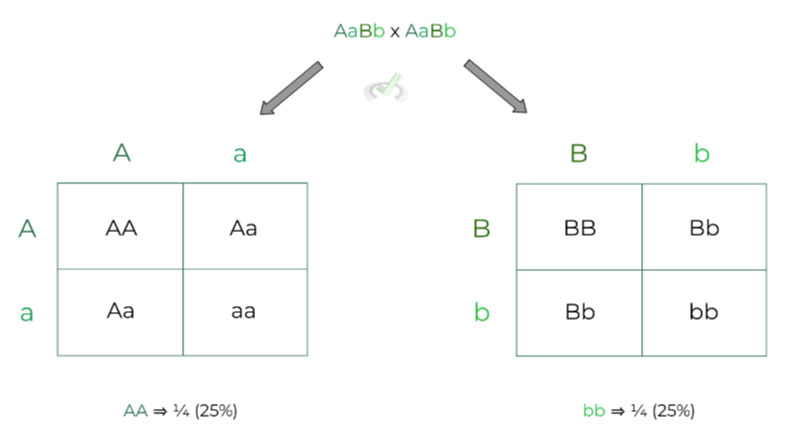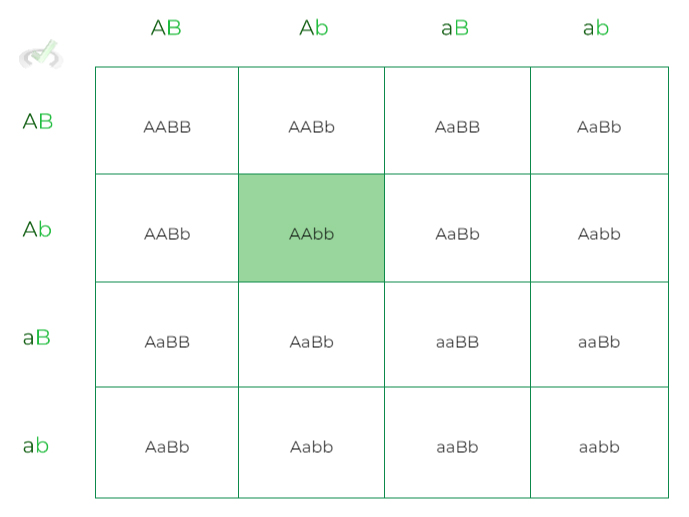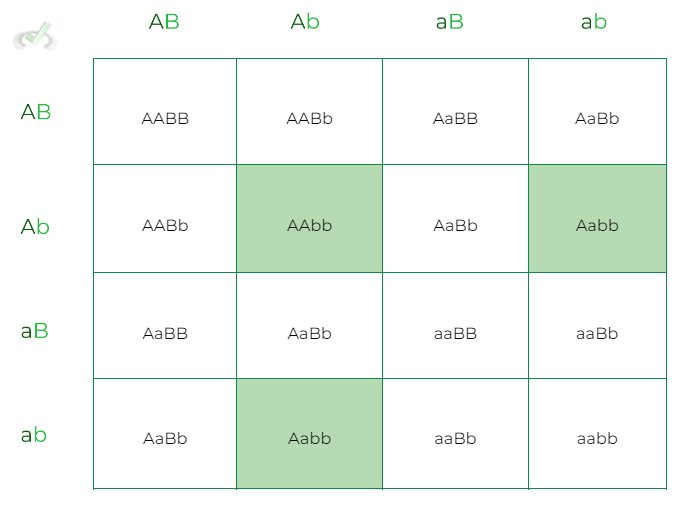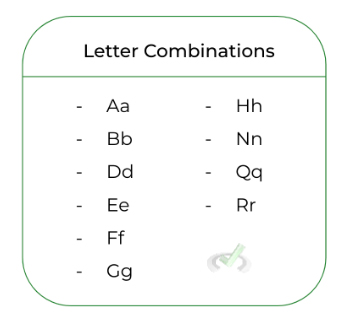I. What are Punnett Square Tips?
As you’ve probably noticed, punnett squares are pretty fun and easy when dealing with monohybrid crosses (i.e. one trait). However, you’ve also may have noticed how much harder these punnett squares become when dealing with 2 traits for dihybrid crosses!
Instead of a simple monohybrid cross, now all of a sudden a 2x2 (4 box) square becomes a 4x4 (16 box) square, adding to the complexity of the punnett square and not make them as fun 
As a matter of fact, adding an additional trait to the square doesn’t make it that much harder: it’s just more time consuming to fill out the punnett square. Luckily we’ll cover some tips we’ve found that can hopefully speed your ability to solve punnett squares!
II. Content Review
Because of the time crunch when taking the MCAT, we really can’t afford to fill out a 4x4 (16 box) punnett square if encountered on the MCAT. Fortunately, there is a strategy we found that can hopefully also help you all.
Most of the time, these dihybrid crosses will deal with complete dominance. In addition, the MCAT will most likely ask you what is the probability of getting this specific genotype or phenotype given a parental cross.
Take a dihybrid cross of AaBb x AaBb, where the different letters code for different traits and the uppercase and lowercase letters represent the dominant and recessive allele, respectively. What is the probability that the offspring will have a genotype AAbb?
Rather than solving the full 4x4 punnett square, split up the punnett square into two 2x2 punnett squares: one for trait A and another for trait B.
Once you’ve found the probability of the specific genotype for each trait, multiply the probabilities together to get the total probability (i.e. the probability that the offspring will have a genotype AA and bb).

As stated above, multiply the individual probabilities in order to get the total probability of the genotype. This is an example of a simultaneous probability case which we’ll talk about more later in the article.

As shown, there is a 1/16 chance that the offspring will have a AAbb genotype. Take a look at the full punnett square below for a better visualization and proof!

The same procedure works for phenotypes.! Take the “A/a” letters to code for hair color: “A” codes for brown & “a” for blonde; likewise, take “B/b” letters to code for hair type: “B” codes for straight & “b” coding for curly. What’s the probability for brown, curly hair?


As shown, there is a 3/16 chance that the offspring will have a brown, curly hair phenotype. Again, the shaded boxes represent the brown, curly hair phenotypes.

III. Bridge/Overlap
While you don’t need to take AP statistics or an upper level statistics course, a basic, superficial understanding of statistics may help you understand the above concepts!
Really the only big thing you have to recognize is to know when to multiply 2 probabilities as shown above in the article or when to add them.
>> Simultaneous Case:
The key word for this case is seeing the word “AND”, as in “what is the probability of event A AND event B occurring?”. In other words, what’s the probability that these 2 events occur simultaneously.
In this case, you MULTIPLY the probability for event A occurring with the probability for event B occurring in order to get the total probability.
An example of this case is shown above! Remember when we were multiplying the probabilities above? We’re basically multiplying the probability of getting a “AA” genotype with the probability of getting a “bb” genotype to get the total probability of getting a “AAbb” genotype.
Here getting a “AA” genotype is event A and getting a “bb” genotype is event B and multiplying them together gives us the probability that these events occur simultaneously.
>> “Either Or” Case:
The key word for this case is seeing the word “OR”, as in “what is the probability of event A OR event B occurring?”. In other words, what’s the probability that either of these events occur, hence the name of the case.
In this case, you ADD the probability for event A occurring with the probability for event B occurring in order to get the total probability.
Take this one example put into the context of punnett squares and mendelian genetics: what is the probability of the genotype being AA or aa? Here, we add the probability of getting a “AA” genotype with the probability of getting a “aa” genotype.
Here getting a “AA” genotype is event A and getting a “aa” genotype is event B and adding them together gives us the probability that EITHER these events occur.
As another tip when doing punnett squares, we recommend using letter pairs that have very different letters for their uppercase and lowercase. Sometimes if the uppercase and lowercase letters are too similar, you can maybe get mixed up in differentiating which is which!
Below are a couple of letter combinations we recommend using when doing these punnett squares!

IV. Wrap Up/Key Terms
Let’s take this time to wrap up & concisely summarize what we covered above in the article!
When dealing with dihybrid (and plus) punnett squares, it’s much more efficient to split up the punnett square into 2x2 punnett squares for each trait. The MCAT will most likely ask you the probability of acquiring a specific genotype or phenotype.
After finding the individual probabilities, multiply them together in order to find the total probability. Look again at the examples shown above!
Likewise, there are 2 probability cases to know about in regards to how to find the total probability.
“Simultaneous” (Key Word: “AND”):
Multiply individual probabilities
“Either Or” (Key Word: “OR”):
Add individual probabilities
V. Practice
Take a look at these practice questions to see and solidify your understanding!
Sample Practice Question 1
Given a parental cross of AABbEE and AaBbee, what is the probability that the offspring will have a genotype of AAbbEe? (To make things easier, all probabilities will have a denominator of 64, the number of boxes for a trihybrid cross).
A. 4/64
B. 8/64
C. 16/64
D. 24/64
Ans. B.
First, split the punnett squares into 2x2 punnett squares for each trait and find the individual probabilities of each of the trait genotypes. The probabilities should be as follows: “AA” (½), “bb” (¼), “Ee” (1).
Multiplying all these probabilities together should give ⅛ and solving for a denominator of 64 should give 8/64.
Note how the probability for trait “E/e” is 1 because when doing the punnett square, “Ee” is the only possible genotype. Think of 1 essentially being 100%.
Sample Practice Question 2
The traits above code for the following phenotypes below: (Uppercase and lowercase letters are dominant and recessive, respectively)
A: Brown Hair a: Blonde Hair
B: Straight Hair b: Curly Hair
E: Long Hair e: Short Hair
What is the probability that the offspring will have blonde, straight, and long hair?
A. 0
B. 16/24
C. 24/64
D. 48/64
Ans. A.
When solving the punnett square for trait A, this answer makes a lot more sense. After solving, you’ll see that there is no genotype (aa) that leads to the recessive blonde hair phenotype.
As such, this results in the probability for that trait being 0. Thus, the resulgiresultig total probability will also be 0.







 To help you achieve your goal MCAT score, we take turns hosting these
To help you achieve your goal MCAT score, we take turns hosting these 





















 reviews on TrustPilot
reviews on TrustPilot